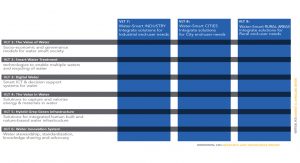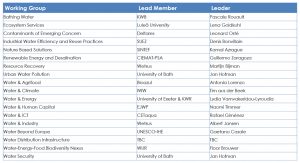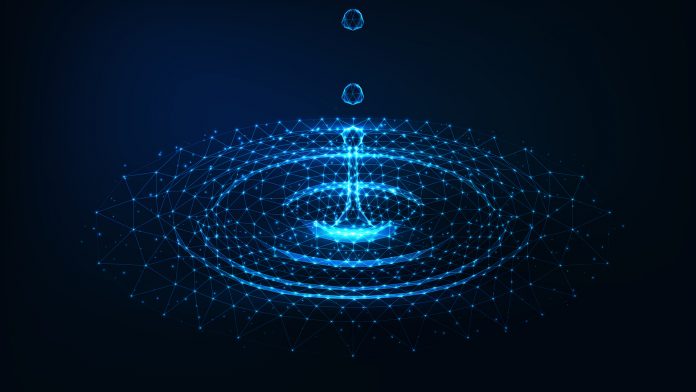Durk Krol, the Executive Director of European Technology Platform Water Europe, discusses the barriers to achieving a water-smart society and how Water Europe is developing the solutions.
Water Europe is the recognised voice and promoter of water-related research, development, and innovation in Europe. Indeed, the European Commission’s DG Research has recognised us as a European Technology Platform (ETP) for water.
Our mission is to improve co-ordination and collaboration in the water sector and those sectors which utilise water in the EU and beyond, as well as to enhance the performance and competitiveness of the European water sector and water-using sectors and to contribute to solving water-related global challenges.
Membership
When we first became a formal Association, we had 11 founding members. We have since evolved and now have around 220 members. A significant part of our strategy is to represent the whole water value chain. In line with that, we have organised our membership into two main categories: corporate members, and associate members; the difference between the two being that corporate members have an influence on our governance, whereas the associated members do not, although they can participate in activities.
The corporate members are divided into five ‘colleges’:
- College A: Multinational corporations;
- College B: Research & technology developers;
- College C: Utilities;
- College D: Suppliers & SMEs; and
- College E: Large water users.
This is in addition to the two colleges for associate members:
- College F: Public authorities; and
- College G: Civil society organisations.
Colleges A, B, and D are solution providers, while colleges C, E, and F are challenge owners.
Each member finds value from their membership in different ways. For instance, some are interested in opportunities for collaboration and research funding – and when it is understood that in 2019 74% of participants in water-related research projects within Horizon 2020 involved Water Europe members, it is clear that this value is being realised.

A vision for a water-smart society
As an ETP, we have defined a long-term vision – ‘The Value of Water: Towards a Future-Proof European Water-Smart Society’, where we have set out a blueprint for a society in which the true value of water is recognised and realised, and where all available water sources are managed in such a way that water scarcity and the pollution of water are avoided, water and resource loops are largely closed to foster a circular economy and optimal resource efficiency, and the water system is made resilient against the impact of climate change events. Thus, the three main challenges we have identified are: too much water; too little water; and polluted water.
In order for a water-smart society to emerge, Water Europe will focus on research, development, and innovation in Europe around four key impact parameters:
- Reducing the impact of Europe’s society on our natural water resources by 50% through increases in efficiency and in alternative water sources (rainwater, brackish, saline, and re-used water) – ‘multiple water’;
- Realising the true value of water for our society, the economy, and the environment in order to increase the rational use and re-use of water – ‘value in water’;
- Boosting the European water market as well as the global competitiveness of European water industries by implementing ambitious long-term investment and innovation programmes, as well as real-life Living Lab experimental areas, creating a fertile innovation eco-system and numerous new green jobs in Europe; and
- Securing the long-term resilience, stability, sustainability, and security of society with regards to water through the achievement of a circular water economy – ‘value in water’.
To realise these objectives, Europe will need to develop innovative water technologies, digital solutions, and economic, business and governance models that contribute to solving water-related challenges in Europe and the world at large. This can be summed up as: multiple water, digital water, hybrid green-grey infrastructure, and extracting energy and substances embedded in the wastewater stream.
‘Multiple water’ deals with the need to increase the reuse and recycling of water in our society, as well as the use of alternative water resources in addition to groundwater and surface water, such as brackish water, saline water, rainwater, etc.
‘Digital water’ includes the use of sensor networks, smart governance, modelling and analysis, and big data. It refers to the potential digitalisation of the water sector which, in the future, will be rolled out throughout the network to the level of the individual user and which will allow for the optimised allocation of available water resources, thereby ensuring that the right water of the right quality arrives at the right place.
‘Value in water’ concerns capturing and exploiting the potential value in wastewater. This includes using it for energy generation, capturing the metals and minerals it contains, and developing business models for regeneration. Furthermore, the COVID-19 pandemic has demonstrated that there is a lot of valuable data in water – for instance, in the Netherlands the first infections were registered after the virus was detected in wastewater before some of the municipalities were actually aware that there were incidences of infection in their area.
Regarding a hybrid grey-green infrastructure, this is essentially the integration of the grey infrastructure into the green one for the provision of services. This also deals with nature-based solutions and with making cities resilient against the effects of climate change.

Main programmes
To implement all of this, we have organised our activities into three main programmes. The first of these is our ‘collaboration programme’, where we represent our members and help them to collaborate. This is typically achieved through our Working Groups and events, where we discuss the challenges and develop innovative solutions.
Second is our ‘advocacy programme’. Here, we try to make water more visible. This is crucial because the water sector in Europe is very fragmented and consists of many small entities. Indeed, just in terms of utilities, there are some 70,000, and this is increased significantly by the number of companies who also exist within the water ecosystem. This fragmentation essentially undermines the strength and visibility of water, and so we have worked to rectify this while simultaneously attempting to ensure that water is seen as a transversal domain – as it touches upon so many different areas, it can become lost from the agenda.
In addition, within our advocacy programme we also undertake regulatory advocacy. It is important to highlight here that there is a difference between advocacy and lobbying, as we are advocating for the general interests of the whole water sector, rather than for a specific group of companies or utilities.
In light of our primary objective of achieving a European water-smart society, we approach our regulatory advocacy activities in different ways as we look to put drivers in place for the uptake of innovative solutions. We will therefore be looking at the Water Framework Directive and its implementation, for instance, as well as the Drinking Water Directive, the Urban Wastewater Treatment Directive, and other European policies as we continue to represent our members in line with our Water Vision.
Our advocacy activities are always based on three systemic criteria. Firstly, the position needs to be in line with our societal responsibilities, as reflected in our Water Vision; second: our decisions should always be evidence-based, taking into account the latest state of science and technology, which comes largely from the input of our working groups and leadership teams; and finally, our position should always be financially and economically sustainable.
Our first priority is thus policy making in terms of hard law, such as the Industrial Emissions Directive and the Urban Wastewater Treatment Directive – the decision has been made, of course, not to revise the water Framework Directive. Second, we will prioritise issues around the European Green Deal and the COVID-19 Recovery Plan, as well as the EU’s Digital Agenda. Our third priority is the implementation of current European law, such as the Drinking Water Directive, the Water Reuse Regulation, and the Water Framework Directive. This in addition to acting as the management body for the MEP water group in the European Parliament.
Our third programme, the Market Programme, helps our members to bring innovative solutions and research results to the market.
For each of these programmes, we have an annual event. For the Collaboration Programme, this is ‘Water Knowledge Europe’, which is our annual brokerage event for European collaborative funding. This recently took place using a digital format because of COVID-19. We are very successful here – as previously mentioned, of all the water-related projects that have been funded under Horizon 2020, 74% of the partners in successful project consortia are our members, and this represents a total value of around €1.5bn.
Water Innovation Europe is our flagship event and looks at the policy agenda, and while Water Market Europe is a standalone event there are also Water Market Europe roadshows, which take place at trade fairs and other events dedicated to a specific theme.
An important element of the Market Programme is our international water dialogues. Of course, in principle we are Europe-oriented as a European Technology Platform, and while solution providers have to be European in order to become a member of Water Europe, we allow problem owners from around the world to join. For example, Coca Cola, which is headquartered in Atlanta, USA, is one such member.
In our international dialogues we work to export our European programmes and objectives to the rest of the world whilst also helping our European solution providers to establish business collaborations with partners in other global regions.
Living Labs
A further important concept within the Market Programme is the Water-oriented Living Labs (WoLLs). In our Water Vision we identified WoLLs as being important instruments to bring new and innovative solutions to the market and to apply them in often complicated contexts. Indeed, because activities within the water sector often need to deal with diverse stakeholders – such as those involved in governance, those involved in innovation, companies, utilities, and so on – it is necessary to create an ecosystem in which you can experiment with new and innovative solutions.
We have therefore developed an atlas of Water-oriented Living Labs and we are continuing to analyse other existing Living Labs to see whether they match our definition of being water-oriented.
Out of 105 water-oriented living lab research sites (in 92 organisational structures), 12 are network platforms; 26 are living lab project-platforms; and 67 are living lab research platforms. 71 water living labs have a maturity level of between 2.5 and 3. The water-oriented living labs have various organisational forms: action labs, associations, clusters, experimental catchments, urban labs, water treatment plants, research platforms, and network platforms. The geographical scale of the majority of living labs is sub-regional.
Leadership teams
In order to implement our Water Vision, we have a matrix of nine Vision Leadership teams. These are essentially Think Tanks within our network which have the responsibility of trying to push the implementation of the key concepts in our Water Vision forwards. This is arranged in a second matrix of six horizontal vision leadership teams, each with its own knowledge- and research-driven theme, and three vertical teams, which are more thematic and market- and Living Lab-driven (see Fig. 1).
We are now working with a number of our leadership teams and others to see how we can move the WoLLs forward and how we can establish a network, because very often these labs can be standalone entities with little or no communication between them. Of course, we want them to communicate more so that they can share their experiences and also discuss best practices when it comes to the business models they have developed to sustain themselves.
In addition to our Vision Leadership teams, which could perhaps be seen as one of the more strategic, top-down instruments that we use to implement our Water Vision, we also have Working Groups (see Fig. 2), which are at the operational level for collaboration in Water Europe. They are member-led and member-driven, and before we allow them to be established we ensure that both adequate governance is in place and that they meet certain conditions, such as a minimum number of people involved and that they can demonstrate interest in that topic from other members. Each Working Group also needs to present a bi-annual work plan and an annual record of their deliverables. They also produce White Papers, which we use as input for our advocacy programme.
Co-ordination activities
As previously mentioned, the water sector in Europe is very fragmented and transversal, and that fragmentation is also evident when it comes to those organisations which represent the sector’s interests. That is, there are numerous umbrella organisations in the European arena that represent one aspect of water, but it is rarely more than that. For instance, they may focus on utilities, or on technology-producing industries, or on a certain area of interest to problem owners. As Water Europe, of course, we represent the whole water value chain, and so we work to bring these different organisations together. To do that, we hold monthly co-ordination meetings where we discuss what each of them is working on and how the different stakeholders can assist one another.
This is not as difficult as one might imagine, as perhaps some 95% of the interests expressed throughout the water ecosystem are held in common. Nevertheless, the remaining 5% can be very difficult to address.
Five years ago we also developed a joint Manifesto for the in-coming European Commission outlining the sector’s main concerns, and we sent letters based on these priorities to 16 different European Commissioners, making the link between what we see as a key objective and their own portfolio. We are now meeting with those different Commissioners and their cabinets to discuss these areas.
When we began working on the Manifesto, there was still a lot of advocacy work to do as we set about explaining why water was relevant to these different policy areas. Now, the different Commissioners are very well aware of the importance of water, which is a very positive sign.
Innovation and European research funding
Research institutes constitute some 45% of our membership, and so placing a focus on collaborative public funding for global research is very important. We facilitate our members in that by, on the one hand, lobbying to try to ensure that water is properly included in the European funding programmes, and, moreover, that this is tied into the priorities that we have identified as an entire sector. We have been successful here, with last year’s Call centring on a European water-smart society and economy, which was extremely close to our own Water Vision, and our members are currently involved in around 14 different European research projects.
Innovation in the water sector is not just about innovative technologies or innovative governance; it is also about having an innovative mindset and about developing innovative human resources. As such, together with some of our partners, we have established the European Junior Water Programme which welcomes eight-10 young people from across Europe annually into a two-year programme. Every three months, they come together for a week to train and develop specific skills, as well as to learn from each other through case studies that they undertake with their respective employers.
Investing in people is crucial for the future of the sector, but so is investing in infrastructure. Cost recovery is thus also an important element that drives innovation. In the utility context, some 80% of service costs are used to pay for infrastructure, and when it is understood that such infrastructure typically has a lifetime of 50-100 years, it is clear that if the proper policies are not in place then huge investments are going to be needed at some point in the not-too distant future. As such, there is a very clear need for investment in the water sector. However, alongside this we must also have long-term, sustainable governance. Water Europe will thus continue its work across all of these areas to ensure that our vision of a water-smart society is achieved.
Please note, this article will also appear in the fourth edition of our new quarterly publication.





